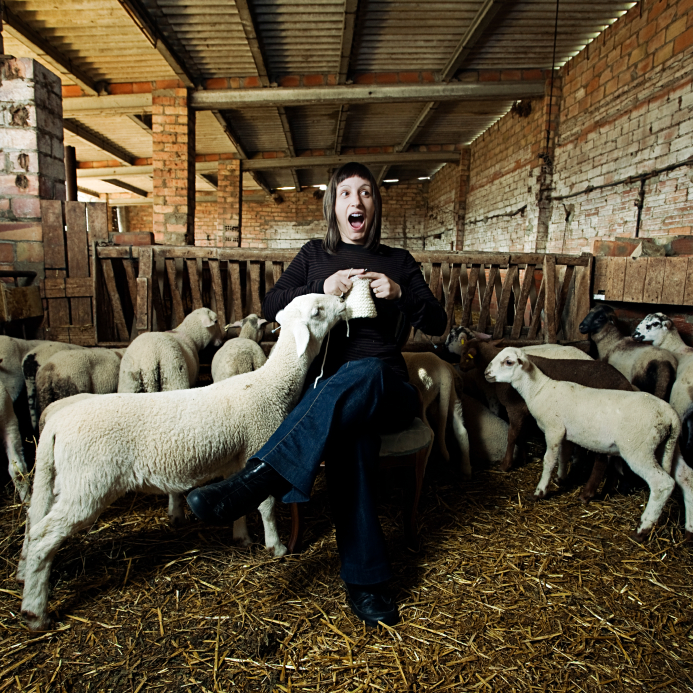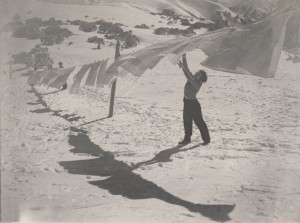
There are a lot of ways to shrink a carbon footprint. Bike instead of drive. Eat low on the food chain. You know the drill. Where I live, in the boondocks of Colorado, a lot of people — myself included, but I’ll get to that in a minute — go on a carbon diet by purchasing some cheap land, rigging up a few solar panels, and getting off the grid.
Most of these people are well-educated, well-meaning, and idealistic, determined to build and garden their way toward some version of a better future. But after living here for more than a decade, I’ve noticed a disturbing susceptibility among these modern homesteaders. I’ll call this recurring disease Not One More Winter In The Tipi, Honey (NOMWITTH).
Here’s what happens: A couple arrives in our valley, young, strong, in love, and full of plans to build an ultra-energy-efficient house out of straw bales, rammed earth, adobe bricks, or, heck, used bottlecaps. They set to work with equal enthusiasm, buying land and setting up temporary quarters in a yurt or a tipi. The weather’s good, the views are great, and the new house is humming along.
But at some point, the weather turns, or the project slows. Or a baby arrives, and everything gets more complicated. For whatever reason, their brio fades, NOMWITTH sets in, and what was once a joint project becomes a battlefield, XX vs. XY. In mild cases, help is hired, the house gets a roof, and all ends well. In more serious cases, one person — inevitably XX — splits town for a fully-furnished condo with central heating, leaving XY alone with the low-carbon dream.
I’ve seen many couples, and carbon budgets, fall prey to NOMWITTH, and the predictability of its gender roles has always bothered me. Women may have different strengths than men, but we don’t lack for toughness — we demonstrate that in feats ranging from mountain-climbing to childbirth. So why does NOMWITTH always seem to strike women first?
Of course, every household is different, and I don’t presume to know exactly what goes on in anyone else’s. But I do wonder if this predisposition to NOMWITTH has historical and cultural roots.
Many scholars — notably Ruth Schwartz Cowan, in her classic book More Work for Mother — have pointed out that the early-20th-century revolution in household technology, despite its many promises, didn’t actually save middle-class women any time. Washing machines meant that people hired fewer servants, had larger wardrobes, and washed their clothes more frequently. Vacuum cleaners led to higher standards of carpet cleanliness. Yet these inventions did change the nature of household work, rescuing women of all classes from at least some of its sweaty, undervalued drudgery.
Too often, modern homesteading asks women to return to the toil so many of their grandmothers left behind. No matter how progressive the homesteading couple, the unfamiliarity and the physical demands of DIY living make it easy to fall into traditional gender roles — to retreat to the stereotypically masculine and feminine skills most of us still learn first and best. The result is that in many modern homesteads, despite highly evolved intentions, men build the houses, and women, like their pioneer-era counterparts, cook over the wood stove. Or scrub the floors. Or care for the babies.

This old-fashioned division of labor means that women are often the first to encounter the worst realities of homesteading. While their partners are outside, impressing the neighborhood with their construction skills, women are inside, confronting the cultural invisibility of domestic work and the social isolation of rural life. Both are working hard, but one gets more public props than the other. Put another way, it doesn’t take too many solo rounds of hand-washing dirty diapers to kill the romance of modern homesteading, and bring on critical NOMWITTH.
I’d advise NOMWITTH sufferers and their partners to strictly moderate their expectations of themselves and others, and monitor their personal ideologies for signs of calcification. Except for a constant watch on domestic divides, though, I don’t think there’s any reliable way to avoid NOMWITTH — but for dumb luck and good timing, I too might have fallen victim to a terminal case.
When I met my husband-to-be here in Colorado, he had, conveniently, just finished work on a 600-square-foot house insulated by straw bales, powered by solar panels, and equipped with a healthy supply of rainwater for hot showers. When we moved in together, I got to enjoy the genuine fun of modern homesteading (dining under the stars, living dirt-cheap) with very little of the drudgery (don’t get me started on the composting toilet, okay?). Because our basic needs — for, say, a roof — were already met, I got to keep the professional career that my feminist mother and my suburban childhood had raised me to expect.
When we had our daughter, we chose cloth diapers, but we also enlisted some help from technology — we bought a low-water washing machine compatible with our power system. And while we bicker about laundry duties like any other couple, it’s assumed that both of us, with roughly equal frequency, will wash the damn diapers.
Begone, NOMWITTH.
(Top photo credit: iStockphoto.)
Terrific post and I KNOW it’s true. Good advice too. Linked to ‘ya from the blog. I love the Homesteaders and the Simple Lifers, but it helps if, at the beginning, you know how to change your own truck oil and you have spent more than three weeks at a time camping in the woods. There will be difficulties, hard work, and doing without!
http://terriermandotcom.blogspot.com/
Interesting story, Michelle. I noticed something somewhat similar during the two+ years we searched for a home in Vermont.
I lost count of the number of houses (regular on-the-grid houses) in various states of construction/finishing that we visited. They were always on lovely parcels of land, 10 acres or more, deep in the woods, at the end of a winding dirt road. And it was always the same story. The couple was building the home of their dreams. The process dragged on. The wife left. The guy was no longer motivated to finish or couldn’t afford to finish and was selling.
They were sad houses, saturated with the psychic unease of broken dreams, promises and hearts. Unlike the off-the-grid places in Colorado, I don’t know that the division of labor was the cause for the desertion because there was power, etc. But for whatever reason the women got fed up and left.
I enjoyed this post too. And like Anne, I can’t help if there’s more going on.
Another key difference in what you describe — in addition to men being outside and in public more, while women are inside and alone — is that men are creating things (root cellars, sheds, fences, whatever) and women are doing the same menial tasks over and over (dishes, laundry, sweeping, cooking). Totally different sense of accomplishment, not to mention the intellectual challenge of building something new.
Anne, that’s so poignant – I’m hesitant to plunge too deeply into gender stereotypes, but I wonder if rural isolation tends to get to women first – especially if there are kids in the picture and the mom is the primary caretaker – no fun raising kids without some form of community support. And Jill, great point, I totally agree – and not only are those tasks menial and boring, but one’s partner comes in with muddy boots/clothes/etc. and makes it necessary to do them all over again! Recipe for resentment.
PBurns – thanks for the kind words and the repost.
Great post, Michelle. Jill, your point really hit a chord with me — that must be why I’d rather be in the garden growing something than in the house sweeping!
Here’s one example (sort of) of it going the other direction. When my great-grandparents more-or-less homesteaded in Wyoming, the two buildings on the land were a granary on stilts and a dugout. My great-grandmother refused to sleep in a hole in the ground, so they slept in the granary. After one too many nights of howling drafts coming up underneath them, my great-grandfather said, “Not One More Night in the Granary, Honey!” and went to the dugout. The family followed and the hole in the ground became home.
Michelle, FWIW, the phenomenon you describe can also easily be observed in northern Idaho.
I love this post, and I’m sure you’re exactly right Michelle. I think the point that Jill U Adams makes is an important one, too–the fact that traditional women’s labor tends to be repetitive and to vanish instead of being a lasting achievement.
One question, though: I live on the Eastern slope, and my impression is that Colorado has a hell of a lot more land than water, so wouldn’t disposable diapers be at least a wash with cloth in terms of their environmental impact? Just wondering.
Thanks, Historiann – re: the diaper question – from what I’ve heard cloth and paper are usually neck and neck in terms of overall resource use, but since our washer is solar-powered, we figured cloth had a bit of an edge in our house.